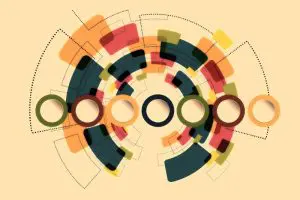When they came onto the scene in the early 2000s, most infographics had quite a similar look. Each one was full of bright colors, stock clipart cartoons, blocky charts, and simple graphs. These days infographic design is as unique as the designers and brands they represent.
Since our brains are wired to process visual information much quicker than by reading text, visual design is a highly effective communication tool. Infographics can convey complex information or data sets in easy-to-understand visual representations. Often these visuals include data-rich charts and graphs, of course, but also images that help to tell a story and catch the viewer’s eye.
To keep audiences engaged, and willing to share infographics, your content should not be allowed to go stale but rather show off some style variation. If you are feeling creatively stuck or looking for new and exciting ways to illustrate information and ideas, here are some design tips for inspiration.

(geralt/Pixabay)
Tips for Infographic Design
Whatever style you choose to go with for infographic design, the primary focus should always be on the information comprehension of the viewer. Every element of a design should be intentional.
1. Remove Elements That Don’t Support the Messaging
Unnecessary text, illustrations, graph embellishments, drop shadows, etc., will clutter up the infographic and make it harder to understand. Your viewer should be able to read and comprehend the data and information quickly.
2. Choose the Clearest Chart
There are many ways of displaying data visually. Consider the primary message, and go with the chart or graph that best represents what you’re trying to get across.
3. Represent the Brand
Branded content should be consistent across all platforms. Mixing up image styles, charts, or other infographic design elements, can still work within the brand identity. Keep in mind branded fonts, colors, and logos you may wish to include.
6 Infographic Image Styles
While much of the story of an infographic is told by the way data or information is displayed on a chart or graph, the addition of images is vital to the viewer’s understanding.
As infographics are visual content pieces to be taken in and comprehended quickly, the addition of images helps to demonstrate the core message of what an infographic is about. Imagery can also help to highlight certain points being made or to represent the brand.
1. Photographs
Photographs help to convey emotion. Human beings respond best to the emotions of other human beings. Including photographs with people in them can help the viewer to connect to a story or message. Photography can also add texture or depth to a design, and landscape photographs can help to establish a sense of place. Original images are always a bonus, but if you don’t have a photographer on staff, you can find many options on stock websites.
2. Illustration
Illustration lends itself to plenty of creativity. Illustration styles are as diverse as the illustrators who make them. Illustrations alongside data sets or graphs can help bring your messaging to life. They can also help the viewer understand complex or abstract ideas. Original illustration is a specific skill that not everyone can manage, however. You may need to hire out for this or find stock illustrations to add to your infographic.
3. Line Art
Line art is clean and simple to understand. Using imagery in your design that is not cluttered or complex can help to tell a straightforward story. Line art can help to keep the focus on the data or information you’re trying to get across. Next to so much content leaning on bright, eye-catching colors and elaborate design, simple line art may actually stand out even more.
4. Animation
With the need to create more eye-catching social media content, and blogs that stand out, animation may be your best bet. Consider video clips, GIFs, and customized animated imagery. Dynamic, moving images add another dimension to your story or data set. They feel modern and exciting and can add a lot to standard charts and infographics.
5. Maps
Whether a map is appropriate depends on the type of information your infographic will be representing. Still, a strategic and visually impactful map can add an unexpected element to your design. Including geographic representation with a map may do more to tell the story than a photograph or illustration.
6. Emojis
This is another element that is not always appropriate, but when used purposefully, it can make a big impact. Emojis today have well-established meanings in society. Tapping into this cultural phenomenon may help younger readers engage with your infographic.
The more unique your infographic design, the more reader engagement you should expect to see. Images added to visual content should be eye-catching, yes, but they should also make sense with the data and the brand. Emojis may not be the best choice for a very professional content piece, for example. Variation in images and design styles will keep your content fresh and your infographics interesting.
